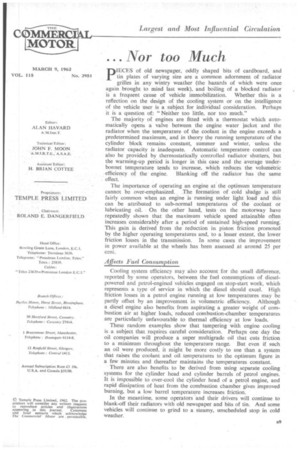. . . Nor too Much
Page 43

If you've noticed an error in this article please click here to report it so we can fix it.
pIECES of old newspaper, oddly shaped bits of cardboard, and tin plates of varying size are a common adornment of radiator grilles in any wintry weather (the hazards of which were once again brought to mind last week), and boiling of a blocked radiator is a frequent cause of vehicle immobilization. Whether this is a reflection on the design of the cooling system or on the intelligence of the vehicle user is a subject for individual consideration. Perhaps it is a question of: "Neither too little, nor too much."
The majority of engines are fitted with a thermostat which automatically opens a valve between the engine water jacket and the radiator when the temperature of the coolant in the engine exceeds a predetermined maximum, and in theory the running temperature of the cylinder block remains constant, summer and winter, unless the radiator capacity is inadequate. Automatic temperature control can also be provided by thermostatically controlled radiator shutters, but the warming-up period is longer in this case and the average underbonnet temperature tends to increase, which reduces the volumetric efficiency of the engine. Blanking off the radiator has the same effect.
The importance of operating an engine at the optimum temperature cannot be over-emphasized. The formation of cold sludge is still fairly common when an engine is running under light load and this can be attributed to sub-normal temperatures of the coolant or lubricating oil. On the other hand, tests on the motorway have repeatedly shown that the maximum vehicle speed attainable often increases considerably after a period of sustained high-speed running. This gain is derived from the reduction in piston friction promoted by the higher operating temperatures and, to a lesser extent, the lower friction losses in the transmission. In some cases the improvement in power available at the wheels has been assessed at around 25 per cent.




































































































































